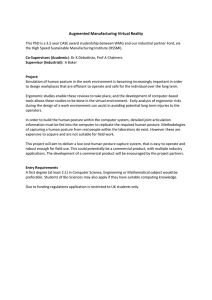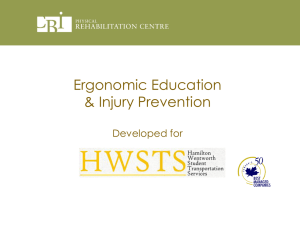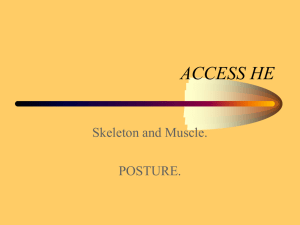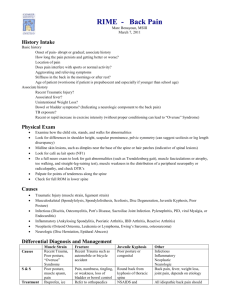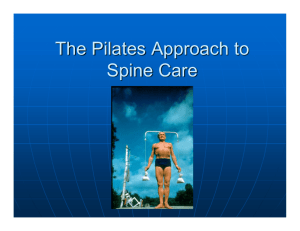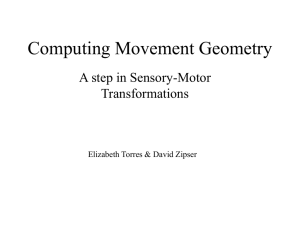Therapeutic Exercises: Posture & Spinal Stability
advertisement
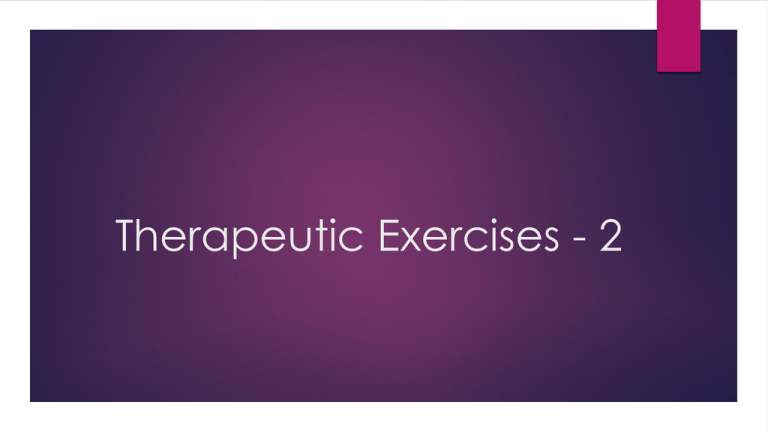
Therapeutic Exercises - 2 Description Of Module Module Title: Therapeutic Exercises - 2 Module ID: PHT 352 Level: 5 المستوى الخامس:مستوى المقرر Credit Hours: 3(1+2+0) 3(1+2+0) :الساعات المعتمدة ٢ تمرينات عالجية:اسم المقرر PHT 352 :رقم المقرر Module Description This course introduces the therapeutic exercises which provide the student with an understanding of the use of various exercise in the prevention and rehabilitation of injury and basic skills involved in relaxation. Module Aims 1. Basic principles, indications, contraindications, physiological & therapeutic effects, precautions & dangers to be considered while performing different types of exercises. 2. Able to express in writing and demonstration of different exercises to be used in the postural rehabilitation, traction (Manual & Mechanical), suspension therapy, relaxation exercises, group exercises & Balance & coordination exercises including the patient and therapist starting positions Objectives of the lecture topic Definition of good posture, various muscles responsible various different abnormal postures, Active and passive and surgical Correction of abnormal posture, General assessment of posture ,different braces used to correct and maintain posture Posture definition * Posture is a “position or attitude of the body, the relative arrangement of body parts for a specific activity, or a characteristic manner of bearing one’s body. * It is alignment of the body parts whether upright, sitting, or recumbent. * It is described by the positions of the joints and body segments and also in terms of the balance between the muscles crossing the joints. * Impairments in the joints, muscles, or connective tissues may lead to faulty postures; * faulty postures may lead to impairments in the joints, muscles, and connective tissues as well as symptoms of discomfort and pain. * Many musculoskeletal complaints can be attributed to stresses that occur from repetitive or sustained activities when in a habitually faulty postural alignment. Lateral view of standard postural alignment * A plumb line is typically used for reference and represents the relationship of the body parts with the line of gravity. Surface landmarks are slightly anterior to the lateral malleolus, slightly anterior to the axis of the knee joint, through the greater trochanter (slightly posterior to the axis of the hip joint), through the bodies of the lumbar and cervical vertebrae, through the shoulder joint and through the lobe of the ear. * Curves of the Spine The adult spine is divided into four curves: two primary, or posterior, curves, so named because they are present in the infant and the convexity is posterior; and two compensatory, or anterior, curves, so named because they develop as the infant learns to lift the head and eventually stand, and the convexity is anterior. Factors That Influence Posture Aging- your body gradually loses its capacity to absorb and transfer forces Inactivity/sedentary living/reluctance to exercise -leads to loss of natural movement flow, Poor postural habits -eventually becomes your structure, Biomechanical compensation → muscle imbalance, adaptive shortening, Body composition – increases load, stresses on spinal structure, leads to spinal Workspace –ergonomics, Poor movement technique/execution/training , Injury -leads to reduced loading capacity or elasticity, Others: *Posture is the single most common cause of painful soft tissue syndromes affecting the body! however its not aging that influences posture as does: muscle weakness & instability within the “core”, deviation, Lordosis and Kyphosis Anterior curves are in the cervical and lumbar regions. Lordosis is a term also used to denote an anterior curve, although some sources reserve the term lordosis to denote abnormal conditions such as those that occur with a sway back. Posterior curves are in the thoracic and sacral regions. Kyphosis is a term used to denote a posterior curve. Kyphotic posture refers to an excessive posterior curvature of the thoracic spine. The curves and flexibility in the spinal column are important for withstanding the effects of gravity and other external forces. The structure of the bones, joints, muscles, and inert tissues of the lower extremities are designed for weight bearing; they support and balance the trunk in the upright posture. Postural Stability In The Spine 1. Spinal stability is described in terms of three subsystems: passive (inert structures/bones and ligaments), 2. active (muscles), 3. and neural control. The three subsystems are interrelated and can be thought of as a three-legged stool; if any one of the legs is not providing support, it affects the stability of the whole. Instability of a spinal segment is often a combination of tissue damage, insufficient muscular strength or endurance, and poor neuromuscular control. Muscles responsible for good posture Abdominal muscles Rectus abdominis, Internal obliques (IO) and external obliques (EO), Transversus abdominis (TrA), Quadratus lumborum , Multifidus, Intersegmental rotators and intertransversarii Superficial erector spinae (ES) muscles (iliocostalis, longissimus, spinalis) Iliopsoas (iliacus and psoas major) Muscles responsible for good posture Sternocleidomastoid and scalene group Upper trapezius and cervical erector spinae. Levator scapulae Longus colli; rectus capitis anterior and lateralis Stabilizing Features of Muscles Controlling the Spine Global muscles Characteristics Core muscles 1. Deep: closer to axis of motion 1- Superficial: farther from axis of motion. 2. 2- Cross multiple vertebral segments. 3. Control segmental motion; segmental guy wire function 4. Greater percentage of type I muscle fibers for muscular endurance • Transversus abdominis, • Multifidus, • Quadratus lumborum (deep portion), • Deep rotators • Rectus capitis anterior and lateralis, • Longus colli 3- Produce motion and provide large guy wire function. 4- Compressive loading with strong contractions. Lumbar region: • Rectus abdominis, • External and internal obliques, • Quadratus lumborum (lateral portion), • Erector spinae, • Iliopsoas Cervical region: • Sternocleidomastoid, • Scalene, • Levator scapulae, • Upper trapezius, • Erector spinae Attach to each vertebral segment Focus on Evidence In a study that looked at 17 mechanical factors and the occurrence of low back pain in 600 subjects (ages 20 through 65), poor muscular endurance in the back extensors muscles had the greatest association with low back pain. Muscle Control in the Lumbar Spine The role of the transversus abdominis (TrA) and multifidus muscles and their function as core stabilizers. These deep muscles have segmental attachments in the lumbar spine and are therefore able to provide segmental control and stiffness. Studies have shown that the deep fibers of the multifidi and TrA are the first muscles to become active when there is postural disturbance from rapid extremity movements. Abdominal muscles The rectus abdominals , external oblique , and internal oblique muscles are large, multi segmental global muscles and are important guy wires for stabilizing the spine against postural perturbations. Muscles of the back Deep core muscles in cervical IMPAIRED POSTURE Postural Habits Good postural habits in the adult are necessary to avoid postural pain syndromes and postural dysfunction. Also, careful follow-up in terms of flexibility and posture training exercises is important after trauma or surgery to prevent impairments from contractures and adhesions. In the child, good postural habits are important to avoid abnormal stresses on growing bones and adaptive changes in muscle and soft tissue. COMMON FAULTY POSTURES: CHARACTERISTICS AND IMPAIRMENTS 1. Pelvic and Lumbar Region . 2. Cervical and Thoracic Region. 3. Frontal Plane Deviations from Lower Extremity Asymmetries 1-Pelvic and Lumbar Region * Lordotic Posture Lordotic posture is characterized by an increase in the lumbosacral angle (the angle that the superior border of the first sacral vertebral body makes with the horizontal, which optimally is 30 degree. An increase in lumbar lordosis, and an increase in the anterior pelvic tilt and hip flexion. It is often seen with increased thoracic kyphosis and forward head and is called kypholordotic posture. Common Causes Sustained faulty posture, pregnancy, obesity, weak abdominal muscles . Scoliosis Scoliosis usually involves the thoracic and lumbar regions. Typically, in right-handed individuals, there is a mild right thoracic, left lumbar Scurve, or a mild left thoracolumbar C-curve. There may be asymmetry in the hips, pelvis, and lower extremities. Structural scoliosis involves an irreversible lateral curvature with fixed rotation of the vertebrae . Rotation of the vertebral bodies is toward the convexity of the curve. In the thoracic spine, the ribs rotate with the vertebrae so there is prominence of the ribs posteriorly on the side of the spinal convexity and prominence anteriorly on the side of the concavity. A posterior rib hump is detected on forward bending in structural scoliosis . SCOLIOSIS Postural scoliosis. Nonstructural scoliosis is reversible and can be changed with forward or side bending and with positional changes such as lying supine, realignment of the pelvis by correction of a leglength discrepancy, or with muscle contractions. It is also called functional or postural scoliosis. Potential Muscle Impairments Mobility impairment in structures on the concave side of the curves. Impaired muscle performance due to stretch and weakness in the musculature on the convex side of the curves. If one hip is adducted, the adductor muscles on that side have decreased flexibility and the abductor muscles are stretched and weak. The opposite occurs on the contralateral extremity. With advanced structural scoliosis, cardiopulmonary impairment may restrict function (RESTRICTIVE LUNG DISEASE). Potential Sources of Symptoms Stress to the anterior longitudinal ligament Narrowing of the posterior disk space and narrowing of the intervertebral foramen. This may compress the dura and blood vessels of the related nerve root or the nerve root itself, especially if there are degenerative changes in the vertebra or disk. Approximation of the articular facets. The facets may become weight bearing, which may cause synovial irritation and joint inflammation. 2- Cervical and Thoracic Region Round Back (Increased Kyphosis) with Forward Head The round back with forward head posture is characterized by an increased thoracic curve, protracted scapulae (round shoulders), and forward (protracted) head. A forward head involves increased flexion of the lower cervical and the upper thoracic regions, increase border of the first sacral vertebral body makes with the horizontal, which optimally is 30 degree, an increase in lumbar lordosis, and an increase in the anterior pelvic tilt and hip flexion. It is often seen with increased thoracic kyphosis and forward head and is called kypholordotic posture. Common Causes The effects of gravity, slouching, and poor ergonomic alignment in the work or home environment. Occupational or functional postures requiring leaning forward or tipping the head backward for extended periods, faulty sitting postures such as working at an improperly placed computer keyboard or screen, relaxed postures, or the end result of a faulty pelvic and lumbar spine posture are common causes of forward head posture. Causes are similar to the relaxed lumbar posture or the flat low-back posture, where there is continued slouching, and overemphasis on flexion exercises in general exercise programs. 3- Frontal Plane Deviations from Lower Extremity Asymmetries Any lower extremity inequality has an effect on the pelvis that, in turn, affects the spinal column and structures supporting it. When dealing with spinal posture, it is imperative to assess lower extremity alignment, symmetry, foot posture, ROM, muscle flexibility, and strength. Frontal plane deviations may also be seen with faulty postural habits such as perpetually standing with a pelvic drop on one side as frequently seen with slouched postures. This may result in muscle imbalances in the hip and spine and an apparent leg-length discrepancy. Common Causes Asymmetry in the lower extremities may result from: structural or functional deviations at the hip, knee, ankle, or foot. Common functional problems include unilateral flat foot and imbalances in the flexibility of muscles. The resulting asymmetrical ground reaction forces transmitted to the pelvis and back may lead to tissue breakdown and overuse, particularly as a person ages, becomes overweight, or is generally deconditioned from inactivity Lordotic increase lumbosacral angle slouched Flat low back Flat upper back and cevicale MANAGEMENT OF IMPAIRED POSTURE Faulty posture underlies many spinal and extremity disorders. Often by simply correcting the underlying postural stresses the primary symptoms can be minimized or even alleviated. Because of this the following guidelines may become a part of many of the interventions. Headaches are often a symptom of faulty posture. GENERAL MANAGEMENT GUIDELINES Before developing a plan of care and selecting interventions for management, evaluate the findings from the examination of the patient, including : the history, review of systems, and specific tests and measures, and document the findings. Postural alignment (sitting and standing), balance, and gait ROM, joint mobility, and flexibility Muscular strength and endurance for repetitions and Holding Ergonomic assessment if indicated Body mechanics Cardiopulmonary endurance/aerobic capacity, breathing Pattern Common impairments and a summary of the information that follows on management of patients with impaired posture . Postural Analysis and Assessment Static Postural Assessment Dynamic Gait Postural Assessment analysis Flexibility Muscle assessment testing Static Postural Assessment Standing on both feet: front, side and rear views Standing on one leg Sitting supported and unsupported Kneeling Supine Sleeping Dynamic Postural Assessment Performing: A push- up A squat- with arms in front, lifting overhead A lunge Walking Lifting Postural Alignment Proprioception and Control Initially, good alignment may be prevented because of restricted mobility of muscle or connective tissue or malalignment of a vertebral segment, but developing patient awareness of balanced posture and its effects should begin as soon as possible in the treatment program in conjunction with stretching and muscle-training maneuvers. MANAGEMENT GUIDELINES—Impaired Posture • Pain (including headaches) from mechanical stress to sensitive structures and from muscle tension • Mobility impairment from muscle, joint, or fascial restrictions • Impaired muscle performance associated with an imbalance in muscle length and strength between antagonistic muscle groups • Impaired muscle performance associated with poor muscular endurance • Insufficient postural control of stabilizing muscles • Decreased cardiopulmonary endurance • Altered kinesthetic sense of posture associated with poor neuromuscular control and prolonged faulty postural habits • Lack of knowledge of healthy spinal control and mechanics MANAGEMENT GUIDELINES ****** Plan of Care Intervention 1. Teach procedures to develop active control of spinal and 1. Develop awareness and control of spinal alignment extremity movement in a variety of positions 2. Demonstrate relationship of symptoms with sustained or 2. Learn awareness between posture and pain repetitive postures 3. Increase mobility in restricting muscles, joints, fascia 4. Develop neuromuscular control, strength, and 3. Manual stretching and joint mobilization; teach selfstretching endurance in postural and extremity muscles 4. Stabilization exercises; progress repetitions and challenge; 5. Learn safe body mechanics progress to dynamic strengthening exercises 6. Learn to correct stress provoking postures/activities 5. Functional exercises to prepare for safe mechanics 7. Learn stress management/relaxation 6. Adapt work, home, recreational environment 8. Improve aerobic capacity 7. Relaxation exercises and postural stress relief 9. Develop healthy exercise habits for self-maintenance 8. Implement and progress an aerobic exercise program 9. Integration of a fitness program, regular exercise and safe body mechanics into daily Visual reinforcement and Tactile reinforcement Use mirrors so the patient can see how he or she looks, what it takes to assume correct alignment, and then how it feels when properly aligned. Verbally reinforce what the patient sees. Tactile reinforcement. Help the patient position the head and trunk in correct alignment and touch the muscles that need to contract to move and hold the parts in place. Cervical Retraction Axial Extension (Cervical Retraction) to Decrease a Forward Head Posture: Patient position and procedure: Sitting or standing, with arms relaxed at the side. Lightly touch above the lip under the nose and ask the patient to lift the head up and away. Verbally reinforce the correct movement of tucking the chin in and straightening the spine, and draw attention to the way it feels. Have the patient move to the extreme of the correct posture and then return to midline. Scapular Retraction Patient position and procedure: Sitting or standing. For tactile and proprioceptive cues, gently resist movement of the inferior angle of the scapulae and ask the patient to pinch them together (retraction). Suggest that the patient imagine “holding a quarter between the shoulder blades.” The patient should not extend the shoulders or elevate the scapula Stretching Techniques for Common Mobility Impairments • Suboccipital region: self-stretch with capital nodding . • Levator scapulae: self-stretch with scapular depression and cervical flexion and rotation to the opposite side • Scalenes: self-stretch with axial extension, side bend neck opposite and then rotate neck toward side of restriction (see position. • Pectoralis major and anterior thorax: self-stretch with corner stretches or lying supine on a foam roll placed longitudinally under the spine • Latissimus dorsi: self-stretch lying supine on a foam roll, reach arms overhead • Lumbar and hip extensors: self-stretch lying supine, bring knees to chest; or quadruped position, move buttocks back over the feet. • Lumbar and hip flexors: self-stretch with prone press-ups or standing back bends . • Tensor fascia lata: self-stretch either side-lying or standing Extend, laterally rotate, then adduct the hip • Hamstring: self-stretch with a straight-leg maneuver either lying supine or long-sitting • Gastrocsoleus (heel cords): self-stretch in a forward stride position with the heel of the back leg maintained on the floor, or stand on an incline board or edge of a step. Streatching of pectoralis major SCALENUS MUSCLES Anterior thorax (a) (B) PECTORALIS MAJOR OTHER INTERNAL ROTATOR References Therapeutic Exercise: Foundations and Techniques, Carolyn Kisner, Lynn Allen Colby, F. A. Davis Company; 2012. Therapeutic Exercise: From Theory to Practice, Michael Higgins, F. A. Davis Company; 2011. Therapeutic Exercise: Moving Toward Function, Lori Thein Brody and Carrie M. Hall, Lippincot Williams & Wiking, 2010.

